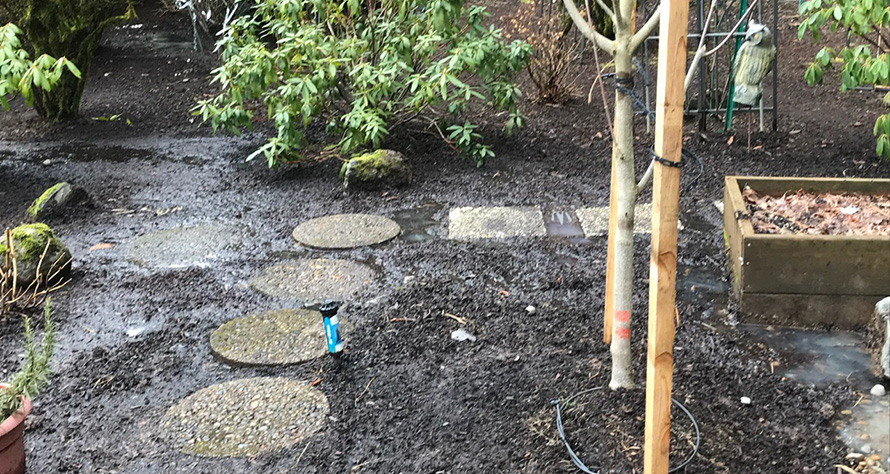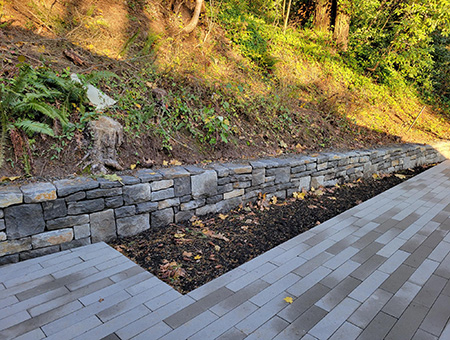How Professional Landscapers Repair Winter Weather Damage in Your Yard

The Pacific Northwest has been experiencing more severe winter weather year over year, and, as a result, homeowners are seeing more damage to their yards. Requests to Landscape East & West to replace or rebuild retaining walls, replace irrigation pipes, and repair soggy lawns are on the rise.
As the spring equinox has finally arrived, now is the time to hire professionals for winter weather recovery and repairs in your yard. Here are some tips for clean-up of winter damage, but we also strongly advise you to give us a call if there are areas of your yard that are suffering from more severe damage, such as retaining walls, lawns, covered structures, etc.
General Winter Recovery Yard Maintenance Tips
Clear Debris: The first step is to remove any fallen branches, twigs, or leaves that accumulated over the winter. This debris can smother grass and plants, making it harder for them to grow.
Evaluate Plants: Check all of your plants and shrubs for signs of damage. If you notice any broken branches or damage to the bark, prune them as soon as possible. Dead plants should be removed and replaced.
Aerate and Reseed: Winter weather can cause soil to become compacted, making it harder for water and nutrients to penetrate. Aerate the soil in your planters and surrounding areas to loosen it up and promote healthy root growth.
Fertilize: Apply a balanced fertilizer to promote healthy growth and help your lawn and plants recover from winter damage.
Irrigation: Make sure your irrigation system is functioning properly, and adjust the watering schedule as needed. During the spring months, your lawn and plants will require more water to thrive. If you discover leaks or other complications with your irrigation system, contact us immediately so we can evaluate the damage and provide an estimate for repairs.
Mulch: Adding mulch to your garden beds can help retain moisture, regulate soil temperature, and reduce weed growth. Make sure to apply the right amount of mulch – too much can suffocate plant roots.
How Landscape East & West Repairs Winter-Damaged Grass
Simply re-seeding or overseeding your lawn won’t help it recover from winter’s rain and freezing ice. Winter weather can cause significant damage to lawns, including dead or brown patches, soil compaction, and fungal growth. To properly repair your lawn, consider calling us to assist you.
Landscape East & West will walk you through the steps to recover your lawn while providing you with the information and care instructions you need to maintain it. You can also hire us to maintain your lawn for you. Life can get busy, and sometimes you just want to come home from work, or put the kids to bed and enjoy your backyard.
Landscape East & West can do the following lawn care for you so you don’t have to!
Rake the lawn: The goal of raking under trees and tall bushes is to remove dead leaves, twigs, and other debris that may have accumulated over the winter. These are the primary culprits when it comes to mold and fungus growth.
Raking will also help to loosen any matted grass or soil that may be preventing new growth.
Aerate the soil: Soil compaction is a common problem after winter weather, and it can prevent water and nutrients from reaching the roots of your grass. Landscape East & West will aerate the soil with a core aerator to help loosen compacted soil and improve drainage.
Re-seed or overseed: Bald patches are a natural occurrence in many lawns, stemming from. uneven soil nutrient distribution. But after aerating the soil, we may need to reseed or overseed those areas. Choose a grass seed that is appropriate for your region and soil type (we can help you decide), and be sure to water the newly seeded areas regularly to keep the soil moist between our regular visits.
Apply fertilizer: As mentioned earlier, uneven nutrient spots are common, but applying fertilizer can help to promote new growth and green up your lawn after the winter. Landscape East & West professionals are familiar with what fertilizer best suits various grass types.
Control weeds: Winter weather can also create favorable conditions for weed growth, so be sure to check for any weeds. We use an herbicide that is safe for your grass type and follow the manufacturer’s instructions when we apply it.
Water regularly: With all necessary maintenance steps in place and with Landscape East & West maintaining your yard and lawn, it’s still important to water regularly to help new grass and seedlings establish themselves. If you don’t have the time to manually water your property, ask us about irrigation systems and how we can install an automatic watering system.
How to Know if a Retaining Wall is Failing Due to Water Damage
There are several signs that a retaining wall may be failing or that you need one in your yard. Winter weather and water damage often show small signs you may not immediately notice. Here are some things to look out for:
Signs your retaining wall might be slowly failing
- Cracks in the wall or bulging, leaning sections
- Soil erosion or bulging at the base of the wall
- Tilting or leaning of the wall
- Water damage or signs of moisture, such as mold or mildew, on the wall or surrounding area
- Loose or missing stones or blocks
- Separation of the wall from adjacent structures, such as stairs or patios
If you notice any of these signs, it’s important to have the retaining wall inspected by a professional landscaper or structural engineer. Landscape East & West can determine the cause of the issue and recommend the best course of action, which may include repairs or replacement of the retaining wall.
 You may need a retaining wall if:
You may need a retaining wall if:
- There is erosion or landslides on slopes or hills beginning to encroach on your yard
- Flooding or standing water in certain areas of your yard often signal underground water sources that can be contained with a stone wall
- Uneven ground or a slope that needs to be leveled – this expands your usable space
- Trees or other vegetation that need to be supported
- A desire to create a terraced garden or level space for outdoor living areas
Landscape East & West begins a retaining wall project with plan and design, working with you to understand your desires for the project and sharing details on stone types, location, and function. If you have an area of your yard with persistent water or containment issues, it’s important to consult professionals before making a decision on a permanent solution. If you’re considering installing a retaining wall, we can determine the best location, materials, and design for your specific needs. We can also advise you on any necessary permits or regulations related to the installation of retaining walls in your area.
Incorporating Attached and Detached Roof Structures For Weather Protection
Covered structures offer year-round protection from the elements, including winter rains and summer sun. Landscape East & West’s covered structures are custom designed and handmade by expert woodworkers to blend seamlessly into your landscape. Here are just a few options we offer:
Attached Pergolas: A pergola is a popular option for homeowners who want to add outdoor living space to their homes. An attached pergola can provide shade and a sense of enclosure to your patio or deck area. A landscaper can design and build a pergola that complements your home’s architecture and landscape design.
Detached Gazebo: A gazebo is another option for adding outdoor living space to your backyard. A landscaper can design and build a gazebo that can be used as an outdoor dining area, reading nook, or relaxation space. A detached gazebo can be placed in a quiet corner of your yard and can be designed to complement the surrounding landscape.
Covered Patio: A covered patio is an excellent option for homeowners who want to add an outdoor living space that can be used year-round. A landscaper can design and build a covered patio that provides shade and shelter from the rain. A covered patio can be attached to your home or can be freestanding.
How the Professionals Fix Cracked Irrigation Pipes After Winter Freezing
The most common cause of cracked irrigation pipes is water left in them over the winter. As the water freezes, it expands within the pipes forcing them to expand beyond their capabilities. The result is splits and cracks in your pipes.
Cracked sections of your irrigation will need to be replaced, and Landscape East & West can quickly identify the source of the weak spots and perform repairs. We can also winterize your pipes in the fall to prevent future damage from taking place.
Have Significant Winter Damage in Your Yard?
We would love to discuss your winter weather repair needs for your yard! From hardscaping to event location design to erosion prevention features, Landscape East & West is ready to help you recover from the winter while turning your space into the outdoor living area you’ve always wanted. Call us at (503) 256-5302 and let’s get started on your project today!
